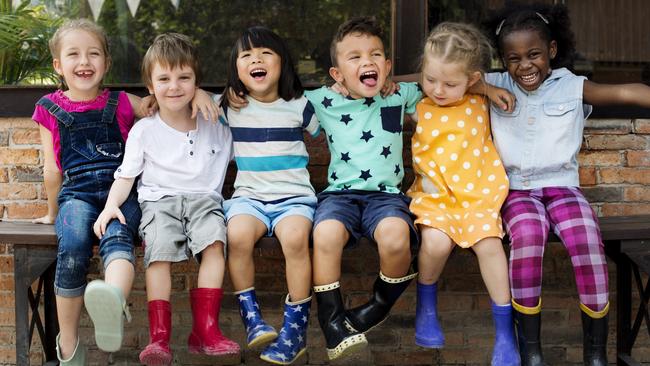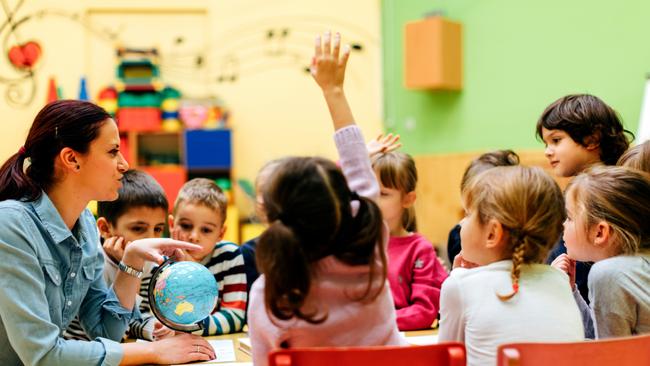Schools Hub: For the sake of our kids, cut down class numbers
Research shows that small class sizes do make a difference for young students as they learn to read and write. So why are our classrooms crammed to capacity, asks Lisa Mayoh. We need urgent action now.
“It’s like herding cats. And dogs. And sheep. All at the same time.”
That’s what my daughter’s kindergarten teacher told me in her first weeks at big school, as I watched him try to corral 30 tired, fidgety five and six-year-olds into the classroom.
Thirty — that’s a lot.
Thirty lost hats. Thirty hands up to go to the bathroom. Thirty kids learning to
read, write, become independent thinkers and kind friends.
Thirty personalities to understand, dynamics to manoeuvre and varying ability levels to co-ordinate.
For next year, the same school has created a third Kindy class, so each will have around 24 kids instead of 30 — and all the parents — and I imagine the teachers — are cheering.

While some studies have shown that class sizes don’t make a huge difference for pupils unless they are fewer than 20 or even 15, more recently, research shows that in the first three years of schooling they do leave a lasting impact, and even more so in lower socio economic areas.
If a student’s parents haven’t finished high school, or English is a second language, pupils come to school with a starting vocabulary of 2000 words.
If their parents are university educated, that’s catapulted to 10,000 words — and an 8000 word head start.
Research shows that small class sizes of 20 or fewer really make a difference at that very delicate time when students are learning to read and write — tricky things they have never done before, and arguably the hardest thing they’ve done so far.
RELATED OPINION: Like it or not, we’re all responsible for poor education
And having more time with the teacher and less personalities to compete for attention with, helps. And that support stimulates growth and confidence, which flows on right through primary and then secondary school.
Of course, there is a funding issue.
It costs a lot to have small classes, and along with it comes teacher training to make sure teaching adapts to smaller groups to capitalise on the benefits of them.
And here in Australia, it looks like we are still behind the Eight ball when it comes to the rest of the world. According to the new OECD report released this week, at an average of 24 pupils in primary school, Australian classes are 14 per cent bigger than the OECD average of 21.

To start turning this around, there needs to be a national standard on class size. Currently, every state and territory is different — as small as 20 in NSW and Western Australian public schools and as big as 27 in public schools in the Northern Territory, up to 32 in NSW Catholic Schools.
It’s unnecessarily confusing, mostly because the figures are buried in teacher workplace
enterprise agreements and are up to each state government to determine.
But why can’t we change that?
Southern Cross University Adjunct Associate Professor David Zyngier, who was asked to review 112 different class size studies from across the world to provide recommendations to government, told me that no kindergarten class should have 30 pupils.
RELATED OPINION: Parents, not schools, are to blame for our education crisis
That a maximum should be 20 kids for lower primary, and even 15 in disadvantaged communities. In secondary classes, 25 should be the maximum.
Australian Education Union Federal President Correna Haythorpe has said it was ‘impossible’ to have a set standard because all of the states and territories have different agreements, industrial or otherwise, about how big class sizes are in their regions.
“There is a direct funding obligation on governments related to the cost of smaller class sizes which is one of the reasons that they fiercely resist reductions in class size various states and territories,” Ms Haythorpe told me.
“The Federal government will not get involved in that argument as they avoid anything that might increase their funding share.”

But don’t we need to take a stand on this now?
With huge projected growth forecasted for the education system over the next few decades, a lack of schools, classrooms and teachers could force sizes up even further.
We need to keep up with the rest of the world. We are the Lucky Country — shouldn’t we be leading the way, not falling behind?
Our recent NAPLAN results further proved how far we have to go, with kids worse off than they were a decade ago. Surely that’s unacceptable. Surely we need to be doing everything we can to put them on the right track, from the very start.
And surely small class sizes will help kids of the future keep up — without getting lost in a crowded room of 30 cats, dogs and cheeky sheep.
